The Using of Concrete Wash Water from Ready Mixed Concrete Plants in Cement Systems
Abstract
:1. Introduction
2. Materials and Methods
3. Results and Discussion
4. Conclusions
Author Contributions
Funding
Institutional Review Board Statement
Informed Consent Statement
Data Availability Statement
Conflicts of Interest
References
- Ghrair, A.M.; Heath, A.; Paine, K.; Al Kronz, M. Waste Wash-Water Recycling in Ready Mix Concrete Plants. Environments 2020, 7, 108. [Google Scholar] [CrossRef]
- Asadollahfardi, G.; Asadi, M.; Jafari, H.; Moradi, A.; Asadollahfardi, R. Experimental and statistical studies of using wash water from ready-mix concrete trucks and a batching plant in the production of fresh concrete. Constr. Build. Mater. 2015, 98, 305–314. [Google Scholar] [CrossRef]
- Sandrolini, F.; Franzoni, E. Waste wash water recycling in ready-mixed concrete plants. Cem. Con. Res. 2001, 31, 485–489. [Google Scholar] [CrossRef]
- Chatveera, B.; Lertwattanaruk, P.; Makul, N. Effect of sludge water from ready-mixed concrete plant on properties and durability of concrete. Cem. Con. Comp. 2006, 28, 441–450. [Google Scholar] [CrossRef]
- Chatveera, B.; Lertwattanaruk, P. Use of ready-mixed concrete plant sludge water in concrete containing an additive or admixture. J. Environ. Manag. 2009, 90, 1901–1908. [Google Scholar] [CrossRef]
- Ružinski, N.; Koprivanec, N.; Dobrović, S.; Stefanović, G.; Tsimas, S.; Zervaki, M. Reuse of wastewater from ready-mixed concrete plants. Manag. Environ. Q. Int. J. 2011, 22, 7–17. [Google Scholar] [CrossRef]
- Ferriz-Papi, J.A. Recycling of fresh concrete exceeding and wash water in concrete mixing plants. Mater. Con. 2014, 64, e004. [Google Scholar] [CrossRef] [Green Version]
- de Matos, P.R.; Prudencio, L.R., Jr.; Pilar, R.; Gleize, P.J.P.; Pelisser, F. Use of recycled water from mixer truck wash in concrete: Effect on the hydration, fresh and hardened properties. Constr. Build. Mater. 2020, 230, 116981. [Google Scholar] [CrossRef]
- Aboelkheir, M.G.; Pal, K.; Cardoso, V.A.; Celestino, R.; Yoshikawa, N.K.; Resende, M.M. Influence of concrete mixer washing waste water on the chemical and mechanical properties of mortars. J. Mol. Struct. 2021, 1232, 130003. [Google Scholar] [CrossRef]
- Markiv, T.; Sobol, K.; Franus, M.; Franus, W. Mechanical and durability properties of concretes incorporating natural zeolite. ACME 2016, 16, 554–562. [Google Scholar] [CrossRef]
- Tran, Y.T.; Lee, J.; Kumar, P.; Kim, K.H.; Lee, S.S. Natural zeolite and its application in concrete composite production. Composites B 2019, 165, 354–364. [Google Scholar] [CrossRef]
- Girskas, G.; Skripkiūnas, G. The effect of synthetic zeolite on hardened cement paste microstructure and freeze-thaw durability of concrete. Constr. Build. Mater. 2017, 142, 117–127. [Google Scholar] [CrossRef]
- Najimi, M.; Sobhani, J.; Ahmadi, B.; Shekarchi, M. An experimental study on durability properties of concrete containing zeolite as a highly reactive natural pozzolan. Constr. Build. Mater. 2012, 35, 1023–1033. [Google Scholar] [CrossRef]
- X-ray S8 Tiger WD Series 2 Technical Details. Available online: https://www.bruker.com/products/x-ray-diffraction-and-elemental-analysis/x-ray-fluorescence/s8-tiger.html (accessed on 17 April 2021).
- D8 Advance Diffractometer (Bruker AXS) Technical Details. Available online: https://www.bruker.com/products/x-ray-diffraction-and-elemental-analysis/x-ray-diffraction/d8-advance.html (accessed on 17 April 2021).
- CILAS 1090 Particle Size Analyzer. Available online: https://www.pharmaceuticalonline.com/doc/cilas-1090-particle-size-analyzer-0002 (accessed on 17 April 2021).
- EN 196-6 Methods of Testing Cement. Determination of Fineness; British Standards Institute: London, UK, 2018. [Google Scholar]
- Zeiss EVO MA and LS Series Scanning Electron Microscopes for Materials Analysis and Life Science. Carl Zeiss SMT: Oberkochen, Germany, 2008. Available online: https://www.scribd.com/document/391914988/EVO-Series-UserGuide (accessed on 17 April 2021).
- The Normative Document of Environmental Protection (The Republic of Lithuania) LAND 63-2004. Water Quality. Determination of Chloride.
- The Normative Document of Environmental Protection (The Republic of Lithuania) LAND 39-2000. Water Quality. Determination of Nitrite.
- The Normative Document of Environmental Protection (The Republic of Lithuania) LAND 65-2005. Water Quality. Determination of Nitrate.
- The Normative Document of Environmental Protection (The Republic of Lithuania) LAND 59-2003. Water Quality. Determination of Total Nitrogen.
- The Normative Document of Environmental Protection (The Republic of Lithuania) LAND 58-2003. Water Quality. Determination of Phosphate and Total Phosphorus.
- LST ISO 8288:1998/P:2009. Water Quality. Determination of Zinc.
- LST ISO 8288:1986. Water Quality. Determination of Lead.
- LST EN ISO 12846:2012. Water Quality. Determination of Mercury.
- ISO 15587-2:2002. Water Quality. Digestion for the Determination of Selected Elements in Water.
- EN 196-3. Methods of Testing Cement. Determination of Setting Times and Soundness (2016).
- Vaičiukynienė, D.; Grinys, A.; Vaitkevičius, V.; Kantautas, A. Purified waste FCC catalyst as a cement replacement material. Ceramics–Silikáty 2015, 59, 103–108. [Google Scholar]
- Allahverdi, A.; Shahrbabaki, M.N.; Ghezelasheghi, M.; Mahinroosta, M. Sulfate resistance of RFCC spent catalyst-blended Portland cement. J. BSECV 2019, 58, 103–114. [Google Scholar] [CrossRef]
- Su, N.; Fang, H.Y.; Chen, Z.H.; Liu, F.S. Reuse of waste catalysts from petrochemical industries for cement substitution. Cem. Con. Res. 2000, 30, 1773–1783. [Google Scholar] [CrossRef]
- Aleknevičius, M. The Influence of Oil Cracking Catalyst Waste on the Properties of Refractory Castables. Ph.D. Thesis, Vilnius Gediminas Technical University, Vilnius, Lithuania, 2010. [Google Scholar]
- Tseng, Y.S.; Huang, C.L.; Hsu, K.C. The pozzolanic activity of a calcined waste FCC catalyst and its effect on the compressive strength of cementitious materials. Cem. Con. Res. 2005, 35, 782–787. [Google Scholar] [CrossRef]
- Vaičiukynienė, D.; Mikelionienė, A.; Kantautas, A.; Radzevičius, A.; Bajare, D. The influence of zeolitic by-product containing ammonium ions on properties of hardened cement paste. Minerals 2021, 11, 123. [Google Scholar] [CrossRef]
- Chen, H.; Feng, P.; Ye, S.; Sun, W. The coupling effect of calcium concentration and pH on early hydration of cement. Constr. Build. Mater. 2018, 185, 391–401. [Google Scholar] [CrossRef]
- Kocak, Y.; Tascı, E.; Kaya, U. The effect of using natural zeolite on the properties and hydration characteristics of blended cements. Constr. Build. Mater. 2013, 47, 720–727. [Google Scholar] [CrossRef]
- Li, Z.; Lu, D.; Gao, X. Analysis of correlation between hydration heat release and compressive strength for blended cement pastes. Constr. Build. Mater. 2020, 260, 120436. [Google Scholar] [CrossRef]
- Ekolu, S.O.; Dawneerangen, A. Evaluation of recycled water recovered from a ready-mix concrete plant for reuse in concrete. J. S. Afr. Inst. Civ. Eng. 2010, 52, 77–82. [Google Scholar]
- Rahhal, V.F.; Pavlík, Z.; Tironi, A.; Castellano, C.C.; Trezza, M.A.; Černý, R.; Irassar, E.F. Effect of cement composition on the early hydration of blended cements with natural zeolite. J. Therm. Anal. Cal. 2017, 128, 721–733. [Google Scholar] [CrossRef]
- Tran, K.A. The Durability of Concrete Using Concrete Plant Wash Water. Master Thesis, University of Waterloo, Waterloo, ON, Canada, 18 June 2007. [Google Scholar]
- de Oliveira, J.S.; Maciel, K.R.D.; Dweck, J.; Andrade, H.M.C.; Gonçalves, J.P. Influence of milling of a reused FCC catalytic waste on the early hydration stages of a special class cement. J. Therm. Anal. Cal. 2021, 1–12. [Google Scholar] [CrossRef]
- Knapen, E.; Van Gemert, D. Cement hydration and microstructure formation in the presence of water-soluble polymers. Cem. Con. Res. 2009, 39, 6–13. [Google Scholar] [CrossRef]
- Gabrovšek, R.; Vuk, T.; Kaučič, V. Evaluation of the hydration of Portland cement containing various carbonates by means of thermal analysis. Acta Chim. Slov. 2006, 53, 159–165. [Google Scholar]
- Kaminskas, R.; Kubiliūtė, R.; Prialgauskaitė, B. Smectite clay waste as an additive for Portland cement. Cem. Con. Com. 2020, 113, 103710. [Google Scholar] [CrossRef]
- Taghizadeh, M.; Asadollahfardi, G.; Salehi, A.M.; Akbardoost, J. Feasibility Study of Reusing Wash Water and Steel Fibre Simultaneously on Workability, Mechanical Properties and Fracture Toughness of Concrete. Austral. J. Civ. Eng. 2021, 1–12. [Google Scholar] [CrossRef]

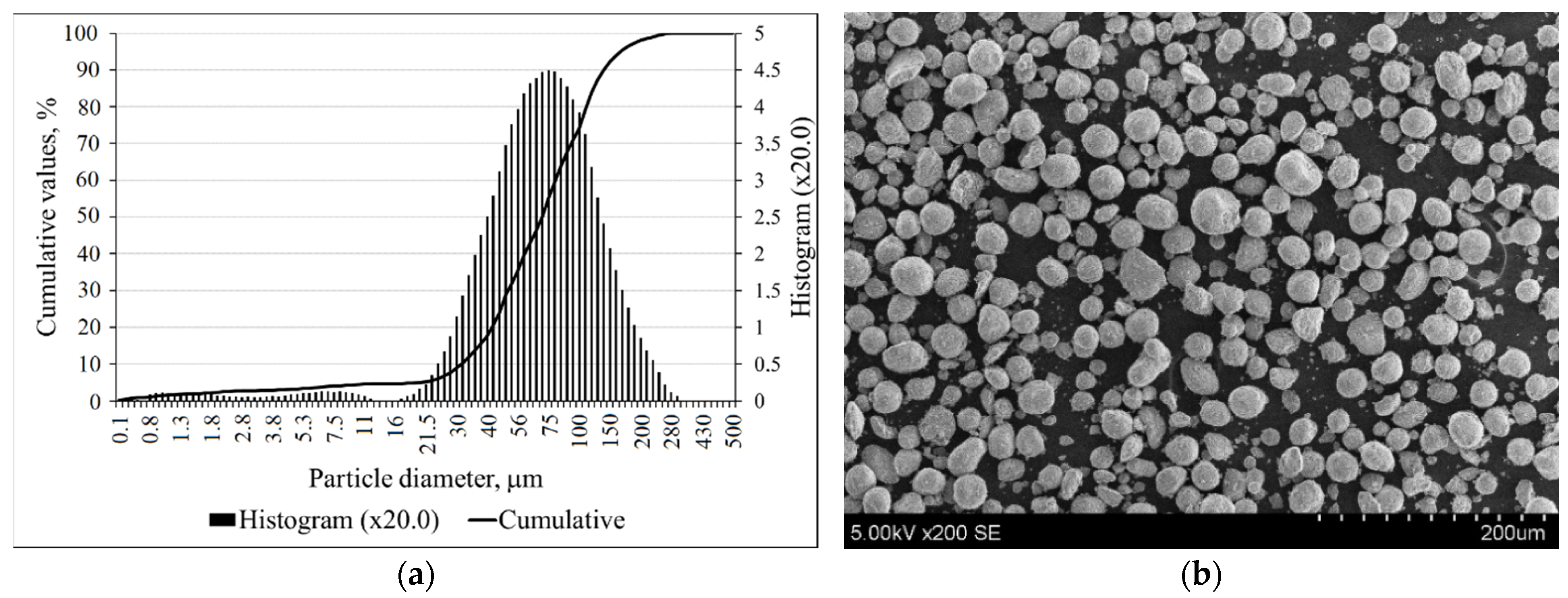
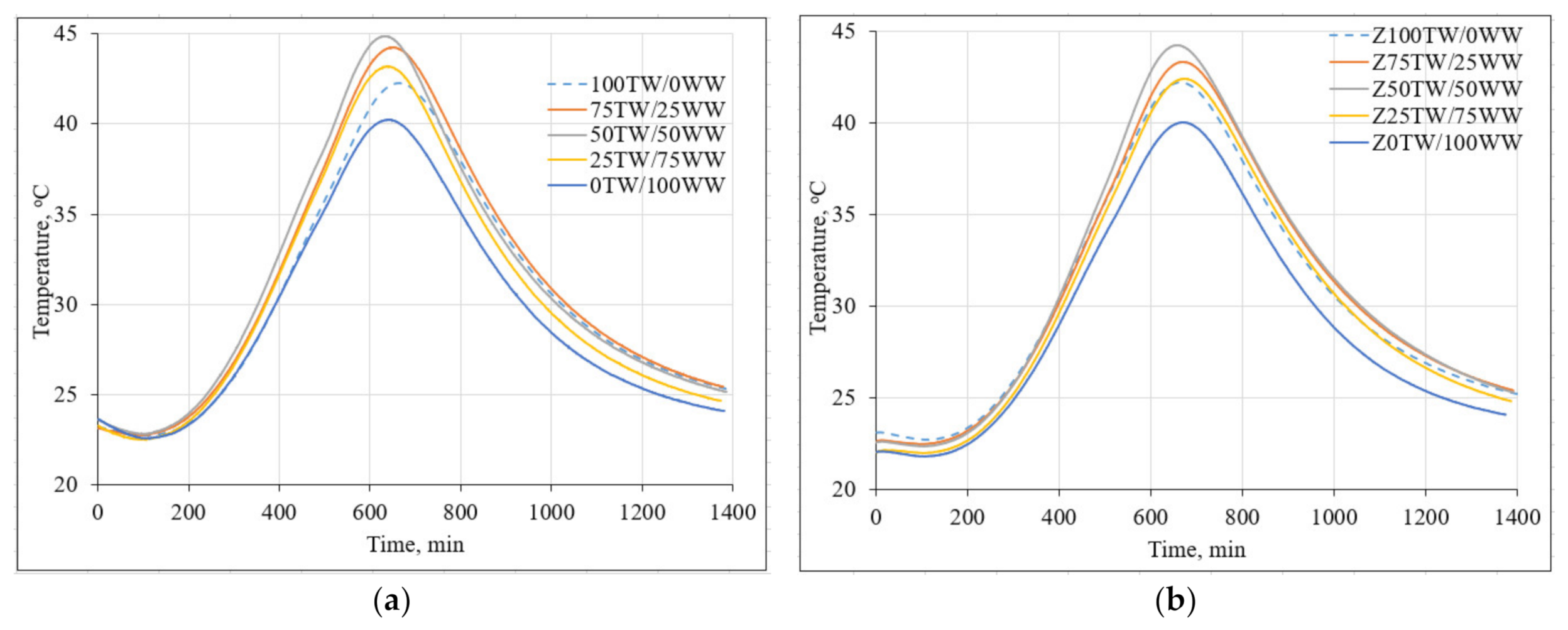

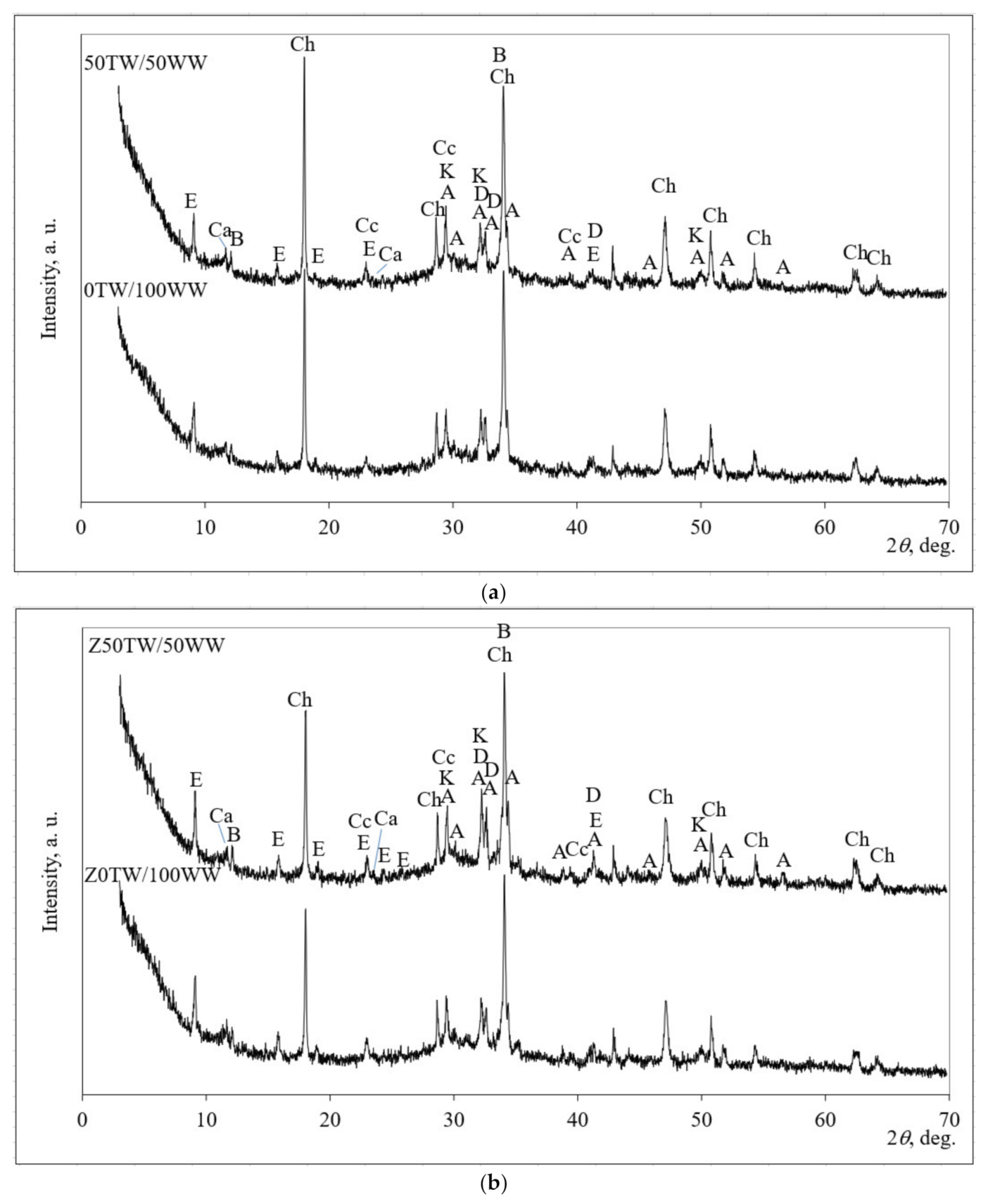
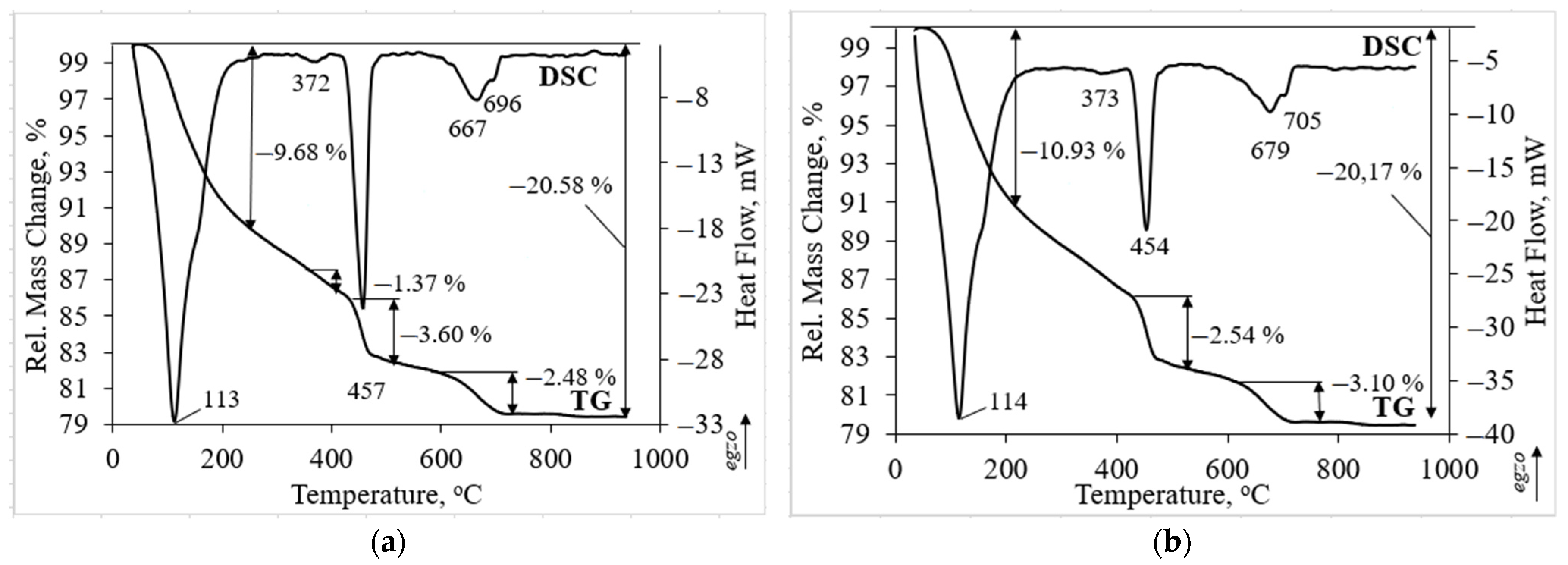
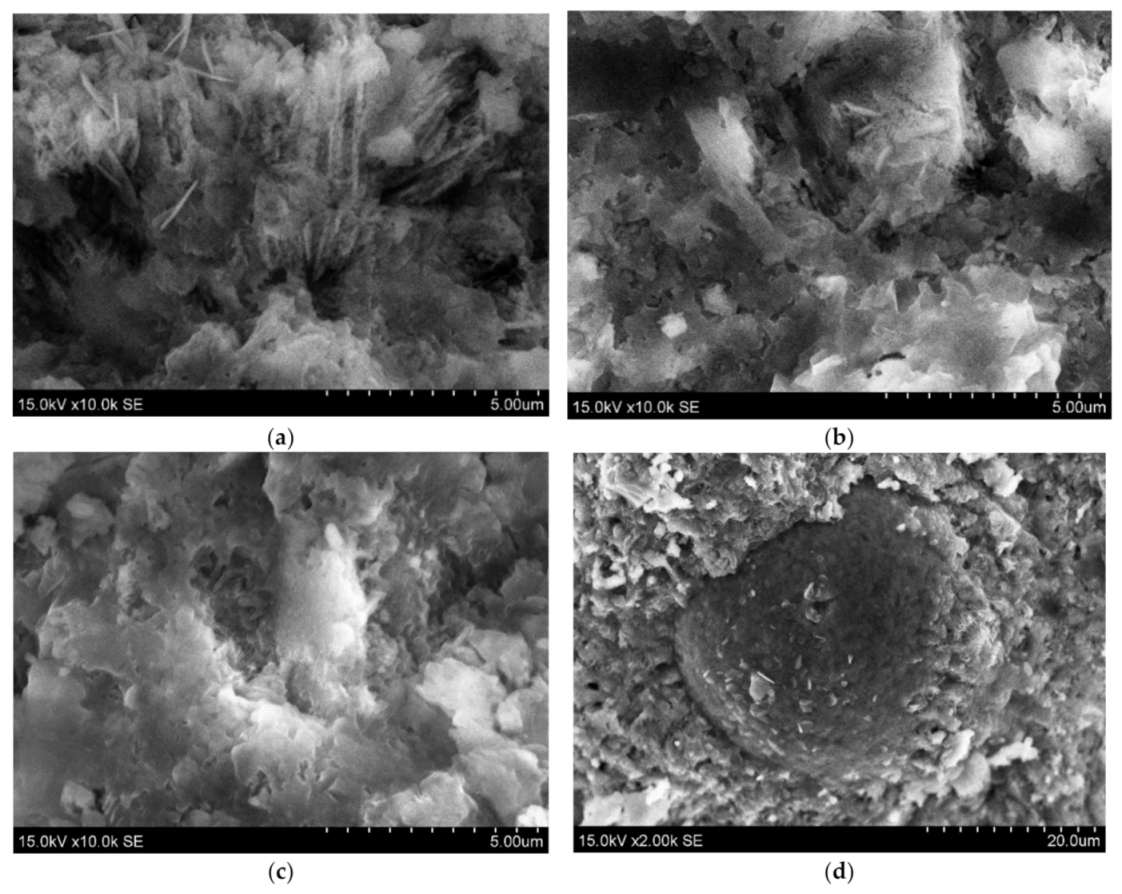
| Oxides | OPC CEM I 52.5R | Zeolitic by-Product |
|---|---|---|
| SiO2 | 21.00 | 35.40 |
| Al2O3 | 3.90 | 48.77 |
| Fe2O3 | 2.90 | 1.02 |
| La2O3 | n | 1.63 |
| TiO2 | n | 3.57 |
| MgO | 2.70 | 0.44 |
| CaO | 66.00 | 0.37 |
| Na2O | n | 0.312 |
| SO3 | 3.40 | 0.07 |
| P2O5 | n | 0.08 |
| K2O | n | n |
| Cl | 0.06 | 2.57 |
| Other | n | 5.77 |
| Bulk Density, kg/m3 | 1236 | 864 |
| Specific Density, kg/m3 | 3122 | 2679 |
| Surface Area (Blaine), m2/kg | 350.0 | 142.1 |
| Parameter | Units | Value |
|---|---|---|
| pH | 12.37 | |
| Chlorides | mg/L | <4.5 |
| Nitrite Ion | mg/L | 0.022 |
| Nitrate Ion | mg/L | 0.14 |
| Total Nitrogen | mg/L | 3.3 |
| Phosphate | mg/L | 0.16 |
| Total Phosphorus | mg/L | 1.6 |
| Sulphate | mg/L | 19 |
| Calcium | mg/L | 867 |
| Zinc | mg/L | 0.94 |
| Mercury | mg/L | 0.33 |
| Lead | mg/L | 0.17 |
| Total Solids | mg/L | 852 |
| Samples | Portland Cement (wt.%) | Zeolitic by-Product (wt.%) | Tap Water (wt.%) | Concrete Wash Water (wt.%) | W/S 1 |
|---|---|---|---|---|---|
| 100TW/0WW | 100 | 0 | 100 | 0 | 0.35 |
| 75TW/25WW | 100 | 0 | 75 | 25 | 0.35 |
| 50TW/50WW | 100 | 0 | 50 | 50 | 0.35 |
| 25TW/75WW | 100 | 0 | 25 | 75 | 0.35 |
| Z0TW/100WW | 100 | 0 | 0 | 100 | 0.35 |
| Z100TW/0WW | 95 | 5 | 100 | 0 | 0.35 |
| Z75TW/25WW | 95 | 5 | 75 | 25 | 0.35 |
| Z50TW/50WW | 95 | 5 | 50 | 50 | 0.35 |
| Z25TW/75WW | 95 | 5 | 25 | 75 | 0.35 |
| Z0TW/100WW | 95 | 5 | 0 | 100 | 0.35 |
Publisher’s Note: MDPI stays neutral with regard to jurisdictional claims in published maps and institutional affiliations. |
© 2021 by the authors. Licensee MDPI, Basel, Switzerland. This article is an open access article distributed under the terms and conditions of the Creative Commons Attribution (CC BY) license (https://creativecommons.org/licenses/by/4.0/).
Share and Cite
Vaičiukynienė, D.; Kantautas, A.; Tučkutė, S.; Manhanga, F.; Janavičius, E.; Ivanauskas, E.; Rudžionis, Ž.; Gaudutis, A. The Using of Concrete Wash Water from Ready Mixed Concrete Plants in Cement Systems. Materials 2021, 14, 2483. https://doi.org/10.3390/ma14102483
Vaičiukynienė D, Kantautas A, Tučkutė S, Manhanga F, Janavičius E, Ivanauskas E, Rudžionis Ž, Gaudutis A. The Using of Concrete Wash Water from Ready Mixed Concrete Plants in Cement Systems. Materials. 2021; 14(10):2483. https://doi.org/10.3390/ma14102483
Chicago/Turabian StyleVaičiukynienė, Danutė, Aras Kantautas, Simona Tučkutė, Fallon Manhanga, Eugenijus Janavičius, Ernestas Ivanauskas, Žymantas Rudžionis, and Aloyzas Gaudutis. 2021. "The Using of Concrete Wash Water from Ready Mixed Concrete Plants in Cement Systems" Materials 14, no. 10: 2483. https://doi.org/10.3390/ma14102483
APA StyleVaičiukynienė, D., Kantautas, A., Tučkutė, S., Manhanga, F., Janavičius, E., Ivanauskas, E., Rudžionis, Ž., & Gaudutis, A. (2021). The Using of Concrete Wash Water from Ready Mixed Concrete Plants in Cement Systems. Materials, 14(10), 2483. https://doi.org/10.3390/ma14102483








